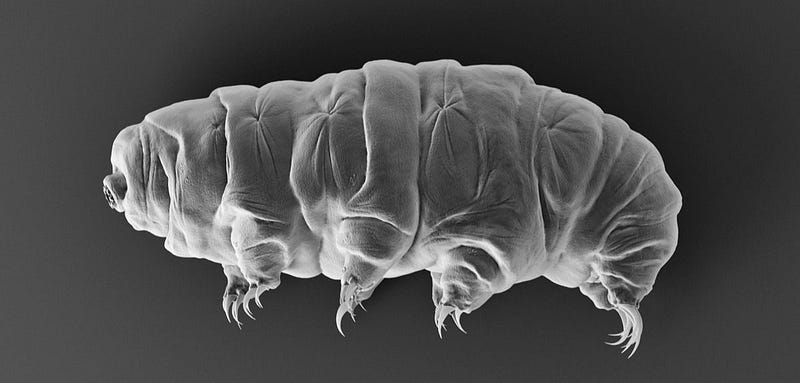The Incredible Tardigrade: Nature's Microscopic Marvel
Written on
Chapter 1: Introduction to Tardigrades
Growing up, I was fascinated by Marvel and DC superheroes, especially the Incredible Hulk, known for his immense strength and resilience to radiation. However, there exists a real-life organism that could rival this fictional giant: the tardigrade. Also referred to as water bears or moss piglets, these microscopic animals have gained fame for their remarkable toughness. But what precisely makes these small, pudgy, eight-legged beings so remarkable?
A Glimpse into Tardigrades
Tardigrades are part of the phylum Tardigrada. Although they are not visible without a microscope, they are omnipresent, found in environments ranging from ocean depths to the Himalayan peaks. These tiny creatures measure only 0.3 to 0.5 millimeters long and are typically discovered in moist habitats such as moss or leaf litter. Their small size has not diminished their allure; scientists and enthusiasts alike are captivated by their almost supernatural capabilities.
Fossil records indicate that tardigrades have existed for over 500 million years, surviving through mass extinctions and significant environmental shifts. This extensive history reveals their extraordinary adaptability and resilience.

Surviving Extreme Conditions
One of the most impressive features of tardigrades is their ability to endure extreme environments. They can survive the vacuum of space, intense radiation, and temperatures ranging from -273°C to 150°C. How do they achieve this?
The secret lies in a process known as cryptobiosis. When faced with harsh conditions, tardigrades can expel nearly all the water from their bodies and curl into a ball, entering a state of suspended animation. In this condition, their metabolism nearly halts, and they produce a sugar called trehalose, which safeguards their cells from harm. They essentially become almost indestructible until conditions improve, at which point they can rehydrate and resume their normal functions.
Tardigrades also possess a unique ability to withstand high levels of radiation. They contain a special protein called Dsup (Damage Suppressor) that protects their DNA from radiation-induced damage. They can endure radiation levels up to 5,000 gray (Gy), while a mere 5 Gy is typically lethal to humans. This remarkable resilience has piqued the interest of scientists, as understanding these mechanisms could have profound implications for space travel and radiation therapy.
Chapter 2: Tardigrades in Space
In 2007, a groundbreaking experiment launched tardigrades into space to test their resilience against the vacuum and radiation of outer space. To the astonishment of researchers, many of the tardigrades not only survived the journey but also managed to reproduce upon their return to Earth. This was the first demonstration that any animal could endure the harsh conditions of space, further solidifying the tardigrade's status as one of the most resilient creatures on our planet.
Their success has led to numerous studies investigating how these minuscule organisms may help us understand the limits of life and the potential for extraterrestrial life. If tardigrades can thrive in space, what does that imply for the existence of other life forms in similarly hostile environments elsewhere in the universe?
Meet The World's Toughest Animal... The INVINCIBLE Tardigrade! - This video explores the incredible resilience and adaptations of tardigrades, showcasing their unique survival abilities.
Impacts on Science and Medicine
The astonishing survival strategies of tardigrades have paved the way for exciting scientific advancements. A primary area of interest lies in medicine, specifically in developing new methods for preserving biological materials. By emulating the cryptobiotic state of tardigrades, scientists aim to enhance the preservation of vaccines, human tissues, and even organs for transplantation.
Moreover, the DNA-protecting Dsup protein holds promise for applications in radiation therapy. If researchers can harness this protein's protective properties, it could lead to more effective ways to shield human cells during cancer treatments or protect astronauts from harmful cosmic radiation during extended space missions.
Researchers at the University of Wyoming are exploring whether integrating tardigrade proteins into human cells could help safeguard healthy cells from radiation damage during cancer therapies. This protective mechanism could allow for higher radiation doses to be used safely, enhancing treatment effectiveness without further harming healthy tissues.
The Ongoing Quest for Tardigrade Knowledge
Despite our understanding of tardigrades, much remains to be discovered. Scientists continue to investigate these creatures to uncover more of their mysteries, such as how they survive without water for decades and their ability to effectively repair DNA. Each finding not only enriches our knowledge of these extraordinary organisms but also offers potential benefits for humanity.
In a world where we strive to adapt and thrive in ever-changing environments, the tardigrade serves as a powerful reminder of life's incredible resilience. Often overlooked, these tiny beings may hold the keys to survival in the most extreme conditions imaginable. As we delve deeper into the boundaries of life on Earth and beyond, the story of the tardigrade is sure to inspire new innovations and discoveries.
Tardigrades Just Being Tardigrades - Water Bears Under The Microscope - This video showcases the natural behaviors of tardigrades, highlighting their unique adaptations and survival strategies.
The tardigrade exemplifies nature's ingenuity. As a microscopic wonder capable of surviving the unimaginable—from the vacuum of space to extreme temperatures—it not only fascinates scientists but also offers valuable insights that could revolutionize our approach to challenges in medicine, space exploration, and beyond.
Next time you encounter a patch of moss, take a moment to reflect on the tiny superheroes that might be residing there, quietly enduring the extremes of the world, one cryptobiotic state at a time. The tardigrade, in all its microscopic splendor, stands as a testament to the enduring power of life in even the harshest circumstances.